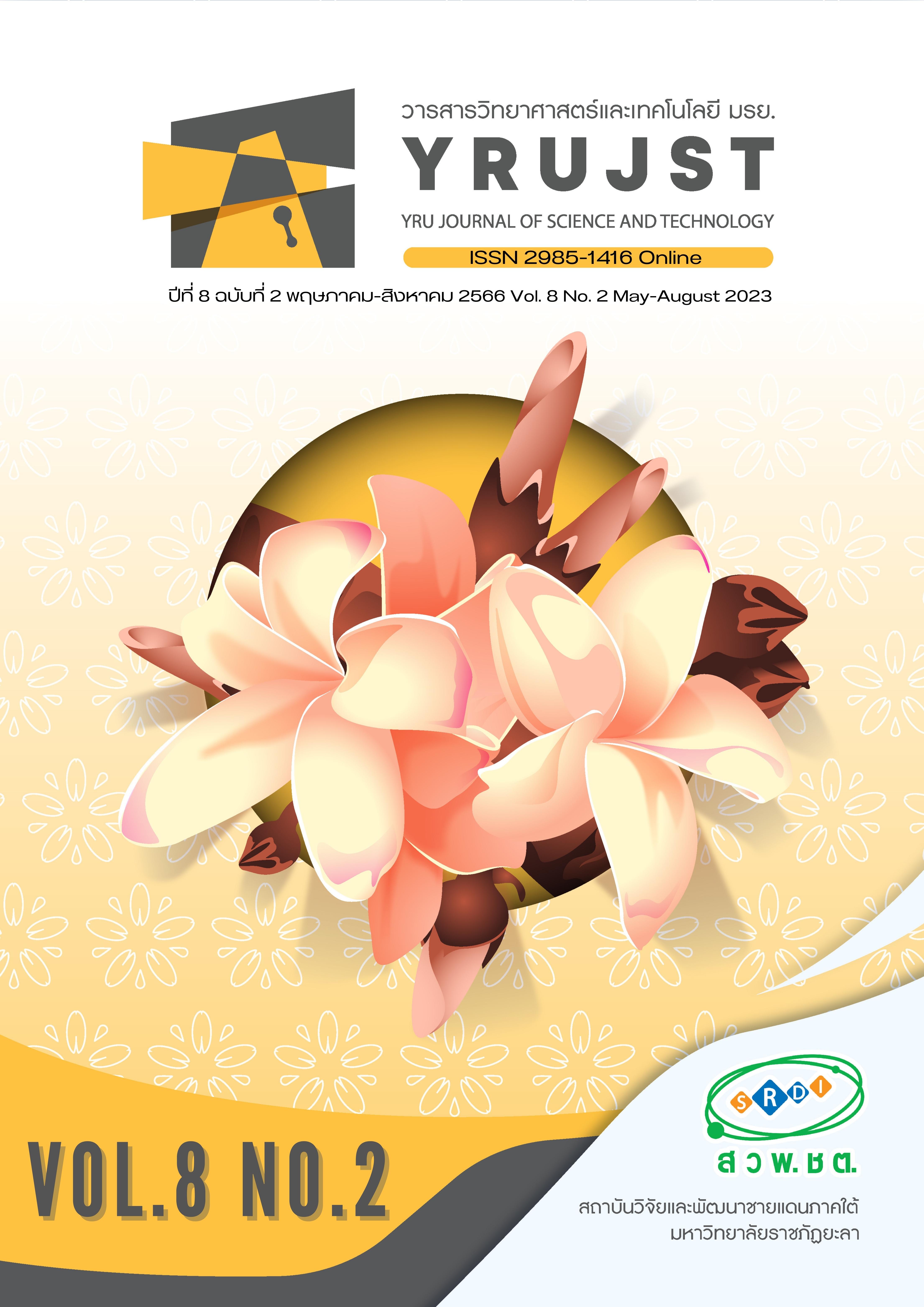Radon Surface Exhalation Rates in Sediment Samples of Mekong River and Lung Cancer Risk, Nakhon Phanom Province, Thailand
Main Article Content
Abstract
Radon, a radioactive gas, is produced through the decay of uranium present in the soil. The levels of radon can fluctuate. As radon undergoes decay, it emits α-particles and undergoes exhalation, leading to the release of the gas from the ground into the air. Inhalation of radon increases cancer risk by damaging DNA through α-particle interactions. To better understand this, an investigative study collected 50 sediment samples at a depth of 20 cm from various districts in Nakhon Phanom province, Thailand (including Ban Phaeng, Tha Uthen, and Mueang districts). Radon concentrations were measured using an active detecting method (RAD 7). The results revealed that radon concentrations ranged from 2.75 to 73.50 Bq/m3, with an average value of 27.69±1.94 Bq/m3. It is noteworthy that all measured radon concentrations were notably lower than the maximum allowable contamination level of 100 Bq/m3, which is recommended by the WHO. Radon surface exhalation rates varied between 1.83 and 48.78 mBq/m2/h, with an average of 18.38±1.29 mBq/m2/h. Notably, the radon surface exhalation rate observed in these studies was lower than the global average value of 57,600 mBq/m2/h, as recommended by UNSCEAR. These findings were crucial in assessing the associated health risks, highlighting significant hazards for individuals. The average annual effective dose (AED) remained below the WHO threshold of 100 µSv/y, and the average number of lung cancer cases per million people (LCC) was calculated as 12.57×10-6. Consequently, these findings indicate that 12.57 out of 1,000,000 people in the research area face a risk of developing lung cancer due to radon exposure in the Mekong River sediments.
Article Details

This work is licensed under a Creative Commons Attribution-NonCommercial-NoDerivatives 4.0 International License.
บทความ ข้อมูล เนื้อหา รูปภาพ ฯลฯ ที่ได้รับการเผยแพร่ในวารสารวิทยาศาสตร์และเทคโนโลยี มรย. นี้ ถือเป็นลิขสิทธิ์ของวารสารวิทยาศาสตร์และเทคโนโลยี มรย. หากบุคคลหรือหน่วยงานใดต้องการนำทั้งหมดหรือส่วนหนึ่งส่วนใดไปเผยแพร่ต่อหรือกระทำการใดๆ จะต้องได้รับอนุญาตเป็นลายลักษณ์อักษรจากวารสารวิทยาศาสตร์และเทคโนโลยี มรย. ก่อนเท่านั้น
References
Alshahri, F., El-Taher, A. & Elzain, A. A. (2019). Measurement of radon exhalation rate and annual effective dose from marine sediments, Ras Tanura, Saudi Arabia, using CR-39 detectors. Romanian Journal of Physics, 64, 811, 1-12.
Amin, S. A., Al-Obaidy, A. H. & Alwan A. (2017). Radon level measurements in soil and sediments at oil field area and its impact on the environment. Engineering and Technology Journal, 35(1), 1-7.
Arshad, N., Abdullah, A., Alias, M., Rosly, M., Abbas, A. R., Saim, N., Osman, R., Hamid, R. D., Syamimi, N. A., Yunus, S. M. & Saat, A. (2019). Radon-222 and naturally occurring radioactive materials (NORMs) radioactivity concentrations and radiological impact assessment of two sediment deposit areas in Cameron Highlands, Pahang. AIP Conference Proceedings. 2068, 020021-1–020021-6. https://doi.org/10.1063/1.5089320
AS-Subaihi, F. A. & Abdulgabar Salem, T. A. (2020). Measurement of radon exhalation rate, annual effective dose and radium activity from marine sediments samples collected from Abian Beach, Aden Gulf, Yemen. Radiation Science and Technology, 6(2), 19-26.
Atyotha, V., Thopan, P., Fungdet, S., & Somtua, J. (2022). Radon exhalation rates of soil samples from Khon Kaen Province, Thailand. Mindanao Journal of Science and Technology, 20, 223-235.
Azhdarpoor, A., Hoseini, M., Shahsavani, S., Shamsedini, N., & Gharehchahi, E. (2021). Assessment of excess lifetime cancer risk and risk of lung cancer due to exposure to radon in a middle eastern city in Iran. Radiation Medicine and Protection, 2(3), 112-116.
Ezzulddin, S. K., & Mansour, H. H. (2020). Radon and radium activity concentration measurement in drinking water resources in Kurdistan Region, Iraq. Journal of Radioanalytical and Nuclear Chemistry, 324, 963-976.
Kaliprasad, C. S. & Narayana, Y. (2018). Distribution of natural radionuclides and radon concentration in Cauvery. Journal of Water and Health, 16(3), 476-486.
Kaliprasad, C. S. & Narayana, Y. (2018). Radon exhalation rate and radon activity in soils of riverine environs of South Karnataka. Radiation Protection and Environment, 41(4), 189-191.
Kaur, M., Kumar, A., Kaur, S., & Kaur, K. (2022). Assessment of radon/thoron exhalation rate in the soil samples of Amritsar and Tarn Taran district of Punjab state. Radiation Protection and Environment, 41(4), 210-214.
Omar, A.S. (2020). Radium content and radon exhalation rates in Egyptian soil samples using active and passive techniques. Radiation Protection and Environment, 43(3&4), 179-184.
Perna, A. F. N., Paschuk, S. A., Corrêa, J. N., Narloch, N. C., Barreto, R. C., Claro, F. D., & Denyak, V. (2018). Exhalation rate of radon-222 from concrete and cement mortar. Nukleonika, 63(3), 65-72.
Raksawong, S., Sola, P., Samran, R. & Pisapak, P. (2021). Measurement of 222Rn exhalation rate from natural rubber latex pillows randomed from online market in Thailand. ASEAN Journal of Scientific and Technological Reports, 24(1), 23-31.
Sun, K., Guo, O., & Cheng, J. (2004). The effect of some soil characteristics on soil radon concentration and radon exhalation from soil surface. Journal of Nuclear Science and Technology, 41(11), 1113–1117.
Thabayneh, K. M. (2018). Determination of radon exhalation rates in soil samples using sealed can technique and CR-39 detectors. Journal of Environmental Health Science and Engineering, 16, 121–128.
Triamvichanon, S. & Tiyapairat, S. (2011). Nakhon Phanom's geology and geological learning resources (1st ed.). Bangkok: Bureau of Geology, Department of Mineral Resources (in Thai).
UNSCEAR. (2000). Sources and Effects of Ionizing Radiation: Annex B. I. UNSCEAR report to the united nations general assembly. New York, USA.
WHO. (2009). WHO handbook on indoor radon: a public health perspective. Switzerland: World Health Organization.


